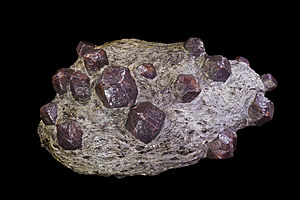Almandine
| Almandine | |
|---|---|
 |
|
| General | |
| Category | Nesosilicate |
|
Formula (repeating unit) |
Fe2+3Al2Si3O12 |
| Strunz classification | 9.AD.25 |
| Crystal system | Cubic |
| Crystal class | Hexoctahedral (m3m) H-M symbol: (4/m 3 2/m) |
| Space group | Ia3d |
| Identification | |
| Color | reddish orange to red, slightly purplish red to reddish purple and usually dark in tone |
| Cleavage | none |
| Fracture | conchoidal |
| Mohs scale hardness | 7 - 7.5 |
| Luster | greasy to vitreous |
| Streak | white |
| Specific gravity | 4.05 (+.25, -.12) |
| Polish luster | vitreous to subadamantine |
| Optical properties | Single refractive, and often anomalous double refractive |
| Refractive index | 1.790 (+/- .030) |
| Birefringence | none |
| Pleochroism | none |
| Dispersion | .024 |
| Ultraviolet fluorescence | inert |
| Absorption spectra | usually at 504, 520, and 573nm, may also have faint lines at 423, 460, 610 and 680-690nm |
| References | |
Almandine /ˈælməndɪn/, also known incorrectly as almandite, is a species of mineral belonging to the garnet group. The name is a corruption of alabandicus, which is the name applied by Pliny the Elder to a stone found or worked at Alabanda, a town in Caria in Asia Minor. Almandine is an iron alumina garnet, of deep red color, inclining to purple. It is frequently cut with a convex face, or en cabochon, and is then known as carbuncle. Viewed through the spectroscope in a strong light, it generally shows three characteristic absorption bands.
Almandine is one end-member of a mineral solid solution series, with the other end member being the garnet pyrope. The almandine crystal formula is: Fe3Al2(SiO4)3. Magnesium substitutes for the iron with increasingly pyrope-rich composition.
Almandine, Fe2+3Al2Si3O12, is the ferrous iron end member of the class of garnet minerals representing an important group of rock-forming silicates, which are the main constituents of the Earth's crust, upper mantle and transition zone. Almandine crystallizes in the cubic space group Ia3d, with unit-cell parameter a ≈ 11.512 Å at 100 K.
...
Wikipedia
